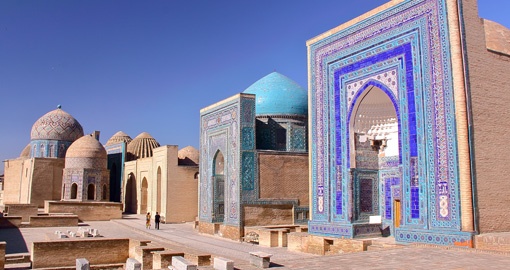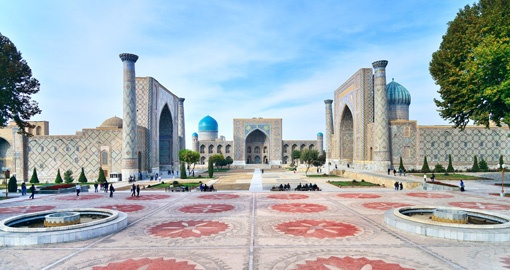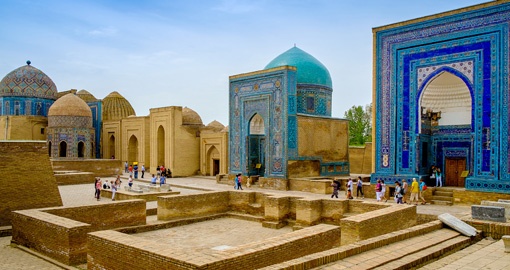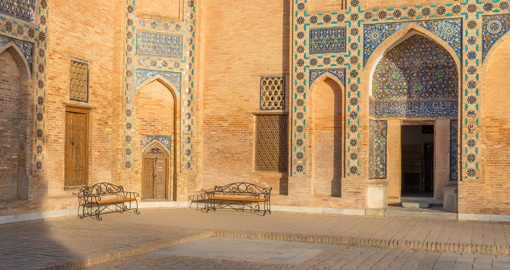Samarkand Vacations, Tours, Travel Packages & Experiences
Samarkand, Uzbekistan’s second-largest city, is one of the oldest inhabited cities in Central Asia, possibly founded around the 7th and 8th Centuries BC. Because of its location, it was an extremely important stop on the Silk Route between China and Europe. In fact, at the time, it was one of the greatest cities in Central Asia. It has been called “The Rome of the East” due to its many archaeological and historical sites. Samarkand is divided into the modern part and the old part. On Uzbekistan tours, it is the latter which attracts the most visitors. There are influences from the days of the invaders and rulers of the Middle Ages such as Alexander the Great, Genghis Khan and Tamerlane. The city has been awarded recognition as a UNESCO World Heritage site due to its unique monuments to be experienced on Uzbekistan travel. It is also known as a major Islamic centre for scholarly study.
Archaeological excavations have unearthed evidence of human activity as early as 40,000 years old. However, its most significant historical period was during the 14th Century when it became the capital of the Empire of Tamerlane which rebuilt most of the city and populated it with skilled artisans and craftsmen from across the Empire. Tamerlane was a patron of the arts. The colour of the buildings in Samarkand also has a significant meaning. Blue is the most common and dominant colour to be found on the buildings used by Tamerlane which symbolized a large range of ideas. For one, the blue shades seen in the Gur-i Amir are colors of mourning. Blue was the colour of mourning in Central Asia at the time so its presence in the city's mausoleum is logical. Also, blue represented water, a rare source in this part of the world. Another dominant colour is gold, a colour which fascinated Tamerlane.
The most important sites in Samarkand during Uzbekistan travel are the following. The Gur-I-Amir Mausoleum is where Tamerlane, along with family members, lies beneath this structure. He had it built for himself made of a single block of dark green jade. The tomb was opened in 1941 and excavated. The entrance to the mausoleum is decorated with Arabic calligraphy and inscriptions, the latter being a common feature in Islamic architecture. Inside, the walls have been covered in tiles. The Registan was a public square during the reign of Tamerlane for royal proclamations and public executions and possibly, the most awesome sight in Central Asia. It contains today, three madrasas (Islamic scholarly schools) of distinctive Islamic architecture. There is the Ulugbek Madrasa from 1420, the Sher-Dor Madrasa from the 17th Century and the Tilya-Kori Madrasa, also from the 17th century. The last has a pleasant, gardenlike courtyard and a mosque intricately decorated with gold. The enormous Bibi-Khanym Mosque is one of the most important monuments in Samarkand. In the 15th Century, it was one of the largest and most magnificent mosques in the Islamic world with its three domed rooms, covered galleries and an open courtyard. It was intended to gather the entire male population of Samarkand for Friday prayers. The interior courtyard contains a huge marble Koran stand. The Shah-i-Zinda is a necropolis. Legend has it that the cousin of the prophet Muhammad was buried here. The Afrosiab Museum was built around one of Samarkand’s most important archaeological sites, a 7th Century fresco of the Sogdian King Varkhouman, discovered in 1965.
There are many other sites on your Uzbekistan travel which belong to the same eras and time in Samarkand will reward the interested visitor.
Samarkand, Uzbekistan
1 Trip Available
-
- Sort by:
- Most Popular
- Duration
- Price
-
![]()
The Legendary Silk Road Railway: Turkmenistan, Uzbekistan & Kazakhstan
FIRST-CLASS | RAIL: Follow the legendary Silk Road back in time across three countries, weaving your way along ancient trade routes aboard a private train. Explore seven stunning UNESCO World Heritage Sites spread across Turkmenistan, Uzbekistan, and Kazakhstan, and experience the colours, sounds, and spirit of medieval market cities.- Duration:
- 14 Days
- Prices:
- On request
- Trip Type:
- Bucket List Travel Ideas, Multi Country Vacation Ideas, Rail Travel Ideas, Small Group Touring
![]() See Trip Details
See Trip Details























